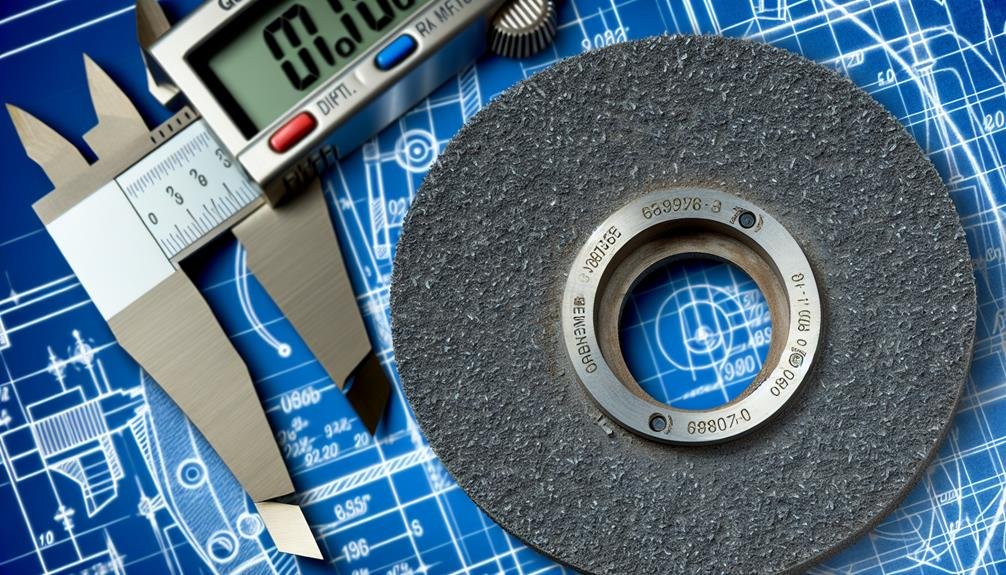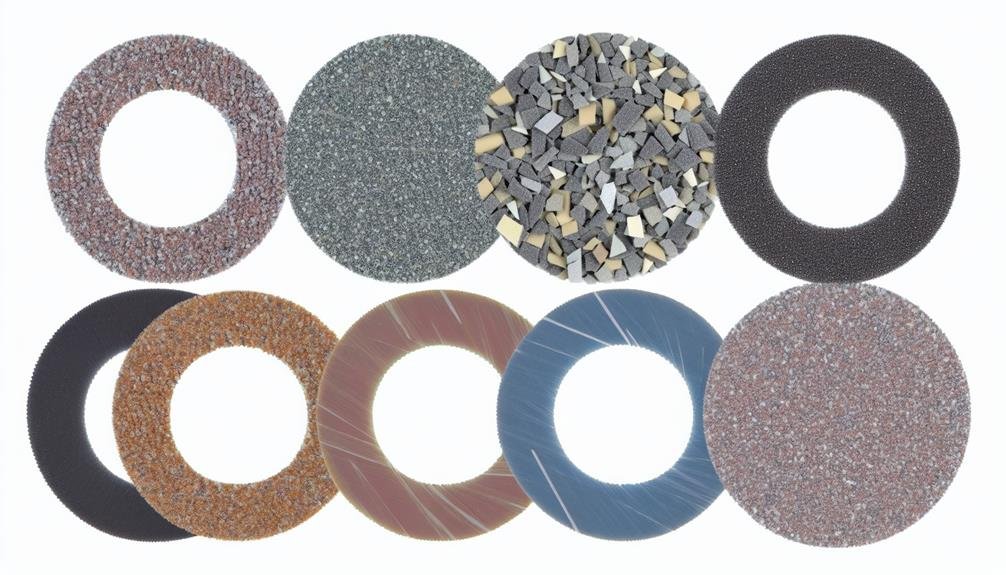Understanding the specifications of an abrasive grinding wheel can often appear as a daunting task due to the myriad of factors that contribute to its functionality and performance. These factors include its diameter, thickness, grit size, abrasive material, bond type, shape, structure, and its particular application. Each element is crucial in determining the wheel's efficiency, durability, and overall performance.
With an in-depth exploration into these parameters, one can not only enhance their knowledge but also optimize the usage and selection process of abrasive grinding wheels. However, the question lingers - What are the precise ways to decode these intricate specifications? Let's unfold this mystery.

Delving into the composition of an abrasive grinding wheel, it is primarily comprised of three essential components: an abrasive grain, a bonding agent, and air or empty space. The composition breakdown reveals that the abrasive grain, which could be aluminum oxide, silicon carbide, zirconia, ceramic alumina, cBN, or diamond, forms the wheel's cutting edge.
The bonding agent, either vitrified or organic, holds the abrasive grains together. The material properties of the bonding agent impact the wheel's hardness and strength. Vitrified bonds provide excellent structural integrity, while organic bonds offer reduced heat resistance but increased flexibility. The air acts as a natural porosity, providing necessary cooling during grinding operations.
The manufacturing process of these wheels adheres to strict industry standards. Superabrasive wheels are meticulously crafted, with the abrasive segment mounted on a hub fabricated from materials like steel, aluminum, carbon fiber, or bakelite. This process ensures that the performance characteristics of the wheel, such as grinding efficiency and lifespan, meet or surpass industry expectations.
Understanding these composition, manufacturing, and performance aspects of an abrasive grinding wheel allows for greater control over grinding operations and results.

Building upon the understanding of an abrasive grinding wheel's composition and manufacturing, the diameter of the wheel emerges as another crucial factor influencing its operational safety, shelf life, and suitability to the workspace. The wheel diameter is primarily chosen based on tool compatibility, as small power tools operate at higher RPM than larger ones.
Fitting a grinding wheel with an incorrect diameter can pose serious safety considerations. Using an 8,500 RPM rated wheel on a 13,000 RPM tool may cause the abrasive to fail, potentially injuring the operator. Moreover, choosing a larger diameter wheel ensures product longevity, especially for applications requiring prolonged use of the grinding wheel.
Workspace constraints also affect the choice of wheel diameter. In cramped spaces, a smaller wheel diameter might be preferable for better access.
| Factors | Impact |
|---|---|
| Wheel diameter | Determines tool compatibility |
| Tool compatibility | Influences safety and efficiency |
| Safety considerations | Impacts operator's risk |
| Product longevity | Affected by wheel diameter |
| Workspace constraints | Influence choice of wheel diameter |

In the realm of abrasive grinding wheel specifications, the thickness of the wheel significantly influences its performance and lifespan. Thickness variations can have a profound effect on the wheel's cutting capabilities and overall performance. It's crucial to understand how different thicknesses can impact the longevity and utility of these tools.

Turning our attention to the concept of 'Grit Size', it's crucial to note that this refers to the diameter of diamond or CBN abrasive grains used in an abrasive grinding wheel. Understanding grit size variations is key to achieving optimal performance in material removal and surface finish.
Grit size comparison across different manufacturers can be challenging. The grit size standards are specified by JIS up to #325 only. Beyond this, each manufacturer establishes their standard independently. This means a grit size #10000 from Company A may not have the same dimensions as Company B's #10000 grit size. Hence, grit size selection requires careful consideration and verification of grain diameters from individual manufacturers.
The grit size impact on abrasive grinding wheel performance is significant. Coarser grit sizes are ideal for higher material removal rates, but they may leave a rougher surface finish. Conversely, finer grit sizes produce smoother finishes but may remove material more slowly.
Among the critical factors that influence the performance of a grinding wheel, the selection of abrasive material stands paramount, often determined by the characteristics of the material being ground. The abrasive composition forms the basis of the wheel's ability to cut, shape, or finish a material, affecting its overall grinding efficiency.
There are primarily two types of abrasives used in grinding wheels:
The choice between natural and artificial abrasive depends on the material compatibility and the desired output. 'Brown' aluminium oxide is often used for grinding ferrous and ferrous alloys, while 'green' silicon carbide is employed for materials that generate significant heat during grinding.

Crucial to the performance of an abrasive grinding wheel, the grain type significantly influences the wheel's cutting and shaping capabilities. The grain sizes, ranging from coarse to fine, directly impact the finish and precision of the grinding process. Larger grains deliver a rougher finish but higher cutting efficiency, while smaller grains offer a smoother finish but slower cutting speed.
The performance characteristics of the grain largely determine the grinding wheel durability and material compatibility. For example, ceramic alumina grains are renowned for their long operational life and are well-suited for hard-to-grind metals. On the other hand, silicon carbide grains, although sharp and fast-cutting, are more fragile, making them suitable for softer materials.
Aluminum oxide grains offer a balance between durability and sharpness, providing consistent performance, particularly with steel and iron. Furthermore, grains can be blended to enhance certain characteristics, such as a blend of zirconia alumina and ceramic alumina for faster cutting.
Understanding these grain characteristics equips you with greater control over your grinding operations, allowing you to select the most efficient and durable grinding wheel for specific tasks and materials.
The bond type of an abrasive grinding wheel is a critical factor that determines its performance and suitability for specific grinding tasks. The bond holds the abrasive grains together, enabling them to cut effectively without falling apart prematurely.
In bond selection, understanding the bond type's characteristics is crucial to ensure its suitability for the specific bond application. Therefore, the bond type should align with the grinding task at hand, whether it requires a high rate of stock removal or a fine finish.

Having examined the importance of bond type in abrasive grinding wheels, we now turn our attention to the various shapes of these wheels, each designed for specific grinding tasks. The wheel shape, or geometry, directly influences the performance and suitability of a grinding wheel for different grinding applications.
| Wheel Shape | Application | Characteristic |
|---|---|---|
| Straight Wheel | Internal, cylindrical, tool, off-hand grinding | Standard for most grinding tasks |
| Cylinder Wheel | Surface grinding | Operates on horizontal and vertical spindle machines |
| Straight Cup Wheel | Surface, off-hand grinding | Useful for achieving a flat surface |
| Flaring Cup Wheel | Tool room grinding, snagging | Supplied with either a plain or bevelled face |
Straight wheels are the most common shape and are used for a wide range of applications, from surface finishing to tool sharpening. Cylinder wheels, on the other hand, are adept at surface grinding, while straight cup wheels excel in providing a flat surface on the workpiece. Lastly, flaring cup wheels are versatile, used for grinding in the tool room and snagging in resinoid bonds. The shape of the wheel impacts its function, thereby emphasizing the need for careful selection based on the task at hand.

What does the structure of an abrasive grinding wheel entail? Primarily, the wheel structure is a key determinant of the wheel's efficiency. It involves the amount of bond present between the individual abrasive grains and how closely these grains are situated to each other.
Understanding these aspects of wheel structure provides control over the choice of grinding wheel for various applications, thereby enhancing productivity and cost-efficiency.

Building on our understanding of the structure of abrasive grinding wheels, we now turn our attention to their practical applications in various industries. Precision grinding is a critical element in various industrial processes, including welding operations and pipe fabrication. The choice of an abrasive grinding wheel can significantly impact the quality and efficiency of these operations.
In welding operations, particularly multipass welding, precision and control are paramount. The use of grinding wheels designed for such applications, such as the Tiger Zirc pipeline grinding wheel, can offer enhanced performance. The wheel's composition and thickness allow for precision bevel grinding, a crucial aspect in producing a high-quality weld bead.
Mechanized welding, especially in pipe fabrication, often requires a different set of specifications. The Tiger Mech wheel is designed specifically for this application, offering a thin profile for precise grinding control without expanding or marring the bevel. This ensures consistent and optimal grinding performance, even in the challenging environment of mechanized welding operations.
To safely use an abrasive grinding wheel, adhere to proper grinding techniques, consistently maintain your wheel, store it correctly, wear appropriate protective gear, and understand potential grinding hazards to mitigate risks.
The costs of abrasive grinding wheels vary, considering factors like wheel durability, price comparison, maintenance expenses, and operational costs. However, investing in high-quality wheels can prove a cost-effective long-term investment.
Replacement of abrasive grinding wheels depends on factors such as wheel durability, grinding efficiency, and visible replacement indicators. Proper storage and regular wheel maintenance can also extend the longevity of the wheel.
Common issues with abrasive grinding wheels include wheel breakage, overheating problems, unbalanced wheels, wheel glazing, and inadequate coolant. Each of these problems can impact the wheel's performance and lifespan significantly.
Yes, abrasive grinding wheels can be recycled or sustainably disposed of. Various recycling methods and green alternatives exist, significantly reducing environmental impact and contributing to waste reduction efforts.
In essence, the specifications of an abrasive grinding wheel are a complex amalgamation of several factors, from diameter and thickness to the grit size, abrasive material, and bond type.
These intricate components, when assembled, form the wheel's unique structure and shape, determining its suitability for certain applications.
A thorough understanding of these specifications is crucial for optimal utilization, ensuring the longevity and efficacy of grinding operations.
GINGONG in China offers high-quality diamond polishing and edge grinding tools alongside ceramic machinery accessories. Our integrated solutions cater to individual needs, ensuring optimal performance and efficiency. We lead the industry in ceramics polishing, emphasizing effectiveness, cost control, and environmental sustainability. With "Sanmo" machines and meticulous attention to detail, GINGONG delivers top-notch abrasive products, setting the standard for excellence.
Contact us for a free quote of your ideal abrasive grinding wheel!
